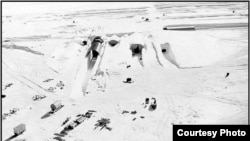Melting ice on the Greenland ice sheet could eventually expose an abandoned U.S. military base that contains hazardous waste, scientists warn.
Camp Century was built in 1959 to look into the possibility of deploying nuclear weapons from the Arctic during the Cold War. The base was closed in 1967, with the notion that any hazardous material left there would be encased in ice forever. However, new research suggests the base could be exposed to the environment as early as 2090.
It is believed the base may contain biological, chemical and radioactive waste in quantities sufficient to “disrupt nearby ecosystems,” the study warns.
"Two generations ago, people were interring waste in different areas of the world, and now climate change is modifying those sites," said William Colgan, a climate and glacier scientist at York University in Canada and lead author of the study. "It's a new breed of climate change challenge we have to think about."
Camp Century covers 55 hectares, “roughly the size of 100 football fields,” about 200 kilometers from Greenland's coast. When it was operating as a U.S. base, up to 200 soldiers lived in "the city under the ice,” as the camp was sometimes called.
Researchers inventoried the waste at the base, “ran climate model simulations” and consulted old engineering records to determine how deep the waste is buried and how much the ice has moved since the 1960s.
The hazardous substances include 200,000 liters of diesel fuel, 240,000 liters of wastewater, polychlorinated biphenyls, or PCBs, and “unknown volume of low-level radioactive coolant from the nuclear generator.”
All of that could enter the environment as the climate warms and the ice sheet melts, researchers said.
"The question is whether it's going to come out in hundreds of years, in thousands of years, or in tens of thousands of years," said James White, a climate scientist at the University of Colorado in Boulder, who was not a part of the study. "This stuff was going to come out anyway, but what climate change did was press the gas pedal to the floor and say, 'it's going to come out a lot faster than you thought.'"
That could be less than 75 years from now.
"When we looked at the climate simulations, they suggested that rather than perpetual snowfall, the site could transition from having a buildup of snow to having primarily melting conditions as early as 2090," Colgan said. "Once the site transitions from net snowfall to net melt, it's only a matter of time before the wastes melt out; it becomes irreversible."
Any possible cleanup of the site could be tricky as the base belonged to the U.S. and Greenland is Danish territory, though self-governing. International law has clearly spelled out rules regarding preventing potential hazardous waste, but it not clear on who is responsible for cleaning up already discarded waste.
The study was published Thursday today in Geophysical Research Letters, a journal of the American Geophysical Union.
Cold War Waste Could Reappear Due to Global Warming
- By VOA News









